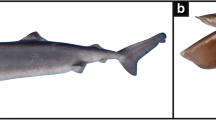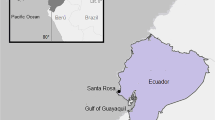Abstract
We examined the stomach contents of cookie-cutter sharks, Isistius brasiliensis, collected by drift-net surveys in the western North Pacific in the early summer. The stomachs contained fresh flesh plugs and cephalopod beaks. Approximately half of the flesh plugs were identified as Bryde’s whale, Balaenoptera brydei, based on genetic analysis, and several of the lower beaks were identified as boreal clubhook squid, Onychoteuthis borealijaponica. The range of estimated dorsal mantle lengths for the squids was 60–172 mm. These results are evidence of predation by of cookie-cutter sharks on cetaceans and of an overlap in the vertical distribution of both species.

Similar content being viewed by others
References
Alves F, Dinis A, Cascão I, Freitas L (2010) Bryde’s whale (Balaenoptera brydei) stable associations and dive profiles: New insights into foraging behavior. Mar Mamm Sci 26:202–212
Árnason Ú, Gullberg A, Widegren B (1993) Cetacean mitochondrial DNA control region: sequences of all extant baleen whales and two sperm whale species. Mol Biol Evol 10:960–970
Best P B, Photopoulou T (2016) Identifying the “demon whale-biter”: Patterns of scarring on large whales attributed to a cookie-cutter shark Isistius sp. PLoS ONE 11:e0152643
Compagno L J V (1984) An annotated and illustrated catalogue of shark species known to date. In: FAO species catalogue, Sharks of the world, Vol. 4. Food and Agricultural Organization, Princeton University Press, Princeton, NJ, pp 93–95
Dwyer S L, Visser I N (2011) Cookie cutter shark (Isistius sp.) bites on Cetaceans, with particular reference to killer whales (Orca) (Orcinus orca). Aquat Mamm 37:111–138
Evans K, Morrice M, Hindell M, Thiele D (2002) Three mass stranding of sperm whales (Physeter microcephalus) in southern Australian waters. Mar Mamm Sci 18:622–643
Goto M, Kanda N, Kishiro T, Yoshida H, Kato H, Pastene L A (2009) Mitochondrial DNA analysis on stock structure in the western North Pacific common minke whales. Paper SC/J09/JR29 presented to the JARPNII review meeting. Yokohama, Japan
Hiruki L M, Stirling I (1993) Wounding in Hawaiian monk seals (Monachus schauinslandi). Can J Zool 71:458–468
Hoyos-Padilla M, Papastamatiou Y P, O’Sullivan F, Lowe D G (2013) Observation of attack by cookiecutter shark (Isistius brasiliensis) on white shark (Carcharodon carcharias). Pac Sci 67:129–134
Jahn A E, Haedrich R L (1987) Notes on the Pelagic Squaloid shark Isistius brasiliensis. Biol Ocean 5:297–309
Jones EC (1971) Isistius brasiliensis, a Squaloid Shark, the Probable Cause of Crater Wounds on Fishes and Cetaceans. Fish Bull 69:791–798
Kanda N, Goto M, Kato H, McPhee M V, Pastene L A (2007) Population genetic structure of Bryde’s whales (Balaenoptera brydei) at the inter-oceanic and trans-equatorial levels. Conserv Genet 8:853–864
Kato H (2002) Bryde’s whales. In: Perrin W F, Würsig B, Hewissen J G M (eds) Encyclopedia of marine mammals. Academic Press, San Diego, CA, pp 171–177
Kubodera T (2002) Manual for the identification of cephalopod beaks in the western North Pacific. https://www.kahaku.go.jp/research/db/zoology/Beak-v1-3/regression/Reg.htm Accessed 23 December 2017
McSweeney D J, Baird R W, Mahaffy S D (2007) Site fidelity, associations, and movements of Cuvier’s (Ziphius cavirostris) and Blainville’s (Mesoplodon densirostris) beaked whales off the Island of Hawai’i. Mar Mamm Sci 23:666–687
Muñoz-Chápuli R, Rey Salgado J C, De La Serna J M (1988) Biogeography of Isistius brasiliensis in the North-Eastern Atlantic, inferred from crater wounds on Swordfish (Xiphias gladius). J Mar Biol Assoc U.K. 68:315–321
Nakano H, Nagasawa K (1996) Distribution of pelagic elasmobranchs caught by salmon research gillnet in the north Pacific. Fish Sci 62:860–865
Nakano H, Tabuchi M (1990) Occurrence of the Cookiecutter Shark Isistius brasiliensis in surface waters of the North Pacific Ocean. Jpn J Ichthyol 37:60–63
Okutani T (2005) Cuttlefishes and Squids of the world. Seizando–shoten publishing, Tokyo
Papastamatiou Y P, Wetherbee B M, O’Sullivan J, Goodmanlowe G D, Lowe C G (2010) Foraging ecology of Cookiecutter Sharks (Isistius brasiliensis) on pelagic fishes in Hawaii, inferred from prey bite wounds. Environ Biol Fish 88:361–368
Sasaki H, Murase H, Kiwada H, Matsuoka K, Mitani Y, Saitoh S (2013) Habitat differentiation between sei (Balaenoptera borealis) and Bryde’s whales (B. brydei) in the western North Pacific. Fish Oceanogr 22:496–508
Shirai S, Nakaya K (1992). Functional morphology of feeding apparatus of the cookie-cutter shark Isistius brasiliensis (Elasmobranchii, Dalatiinae). Zool Sci 9:811–821
Souto L R A, Oliveira J G A, Nunes J A C C, Maia-Nogueira R, Sampaio C L S (2007). Analysis of Cookiecutter shark Isistius spp. (Squaliformes; Dalatiidae) bites in cetaceans (Mammalia: Cetacea) on the Bahia coast, northeastern Brazil. Biotemas 20:19–25
Strasburg D R (1963) The diet and dentition of Isistius brasiliensis, with remarks on tooth replacement in other sharks. Copeia 1963:33–40
Thompson J D, Higgins D G, Gibson T J (1994) CLUSTAL W: improving the sensitivity of progressive multiple sequence alignment through sequence weighting, position-specific gap penalties and weight matrix choice. Nucl Acids Res 22:4673–4680
Widder E A (1998) A predatory use of counterillumination by the squaloid shark, Isistius brasiliensis. Environ Biol Fish 53:267–273
Yoshida H, Higashi N, Ono H, Uchida, S (2010) Finless porpoise (Neophocaena phocaenoides) discovered at Okinawa Island, Japan, with the source population inferred from mitochondrial DNA. Aquat Mamm 36:278–283
Acknowledgements
We thank the captain and crews of the R/V Kaiun-maru of the Aomori Prefectural Industrial Technology Research Center. We also thank Mitsuo Sakai, then of the Tohoku National Fisheries Research Institute, FRA, Jun-ichi Abo, currently of the Tohoku National Fisheries Research Institute, FRA, and Yoshiki Kato of the Marine Fisheries Research and Development Center, FRA, who provided cookie-cutter shark specimens. The study was performed in compliance with the local laws and the Guidelines for the Use of Fishes in Research of the Ichthyological Society of Japan. This work was supported by JSPS KAKENHI Grant Number 4403-A03-2412008 (New Ocean Paradigm on its Biogeochemistry, Ecosystem and Sustainable Use).
Author information
Authors and Affiliations
Corresponding author
Electronic supplementary material
Below is the link to the electronic supplementary material.
About this article
Cite this article
Murakami, C., Yoshida, H. & Yonezaki, S. Cookie-cutter shark Isistius brasiliensis eats Bryde’s whale Balaenoptera brydei. Ichthyol Res 65, 398–404 (2018). https://doi.org/10.1007/s10228-018-0619-6
Received:
Revised:
Accepted:
Published:
Issue Date:
DOI: https://doi.org/10.1007/s10228-018-0619-6




